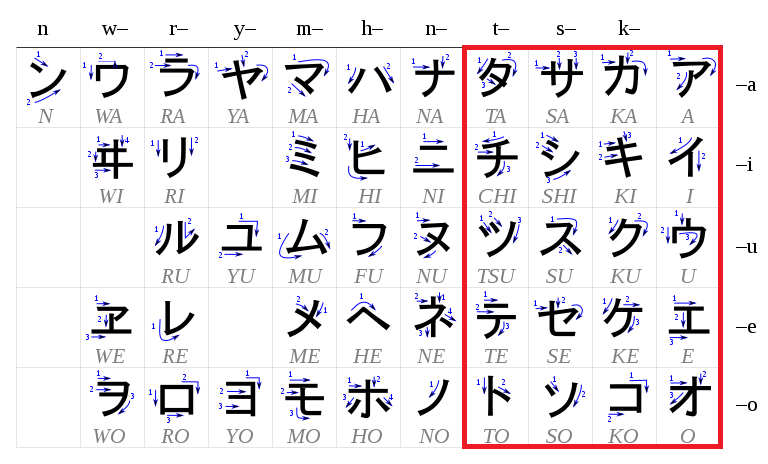Overview

Hello, everyone, and hope you have a great Christmas! Today, we will look at the Katakana table. Katakana is another kind of alphabet, like Hiragana. The letters are mainly used for loan words like クリスマス (Christmas) and sound effects like コンコン (Knocking sound). Each letter in the Katakana table corresponds to a letter in the Hiragana table, so they have the same pronunciation, and additional sounds that can be produced are exactly the same, except for a few exceptions that I will point out.
Now, let us look at how to write out the Katakana in the first four columns!
Katakana (First column)





Katakana (Second column)





Katakana (Third column)





Katakana (Fourth Column)





Additional Sounds
The second to fourth columns of the Katakana table have the same additional sounds as the Hiragana table, with the same exceptions.
For instance, ガ is read like が, while ジ and ぢ are both read as じ or ぢ.
However, there is one main difference, which is that the two lines can be added to ウ (U) to produce ヴ (Vu). It’s not a very useful letter on its own, but more sounds with the V sound can be produced with diphthongs, but we’ll discuss that in another lesson.
Long Vowels
Remember the long vowels in Hiragana? It’s a lot simpler in Katakana, because all you have to do to make a long vowel is to add a line (ー) at the end of the letter.
For example, アー is equivalent to ああ and ソー is equivalent to そう or そお.
Double Consonants
Double Consonants are exactly the same as in Hiragana, so you just add a small ツ preceding the consonant.
For example, チケット, meaning ticket, is pronounced the same way as ちけっと.
Example Words
- ケーキ (Keeki) – Cake
- チケット (Chiketto) – Ticket
- ソックス (Sokkusu) – Socks
- ソース (Soosu) – Sauce
- シーソー (Shiisoo) – Seesaw
- ドア (Doa) – Door
- ザーザー (Zaazaa) – Sound of heavy rain
- ガード (Gaado) – Guard
- ギター (Gitaa) – Guitar
- ゾウ (Zou) – Elephant
Conclusion
In this lesson, we’ve learnt about the first four columns of the Katakana table, the additional sounds that can be produced, as well as long vowels and double consonants in Katakana. If you have any questions, don’t hesitate to post it in the comments section. Hope to see you in the next lesson!

Great write-up, I’m normal visitor of one’s blog, maintain up the excellent operate, and It is going to be a regular visitor for a long time.
I loved your article.Much thanks again. Fantastic.
whoah this blog is excellent i love reading your posts. Keep up the good work! You know, many people are looking around for this information, you can help them greatly.